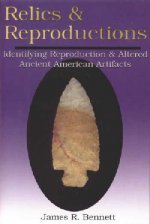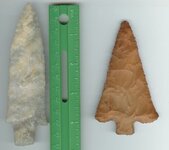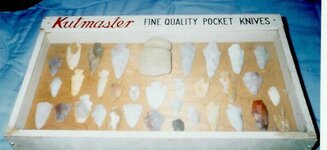A
Atlantis0077
Guest
Greetings,
The classic quandary of the collector.....Here are two spearheads I came across the other day. One appears to be authentic, the other fake. Care to venture a guess as to which is which?
Well upon close inspection they both look pretty good, but in my opinion, by no means professional, the white/grey quartzite point is authentic, while the brown one is a reproduction. They could both be fakes, for I found neither in the field, but it brings up a problem that we all face, that of how do you tell. Well experience helps, but instead of going through a litany of if and wherefore's I will tell you to purchase the following book. Relics and Reproductions by James R. Bennett. This is one of the best reference books I have ever found on the subject.
This book is full of color comparison pictures and gives you a lot of tricks of the trade such as magnifying loupes, UV lights, etc. Also list sources for purchasing these items. I highly recommend it for anyone who is going to seriously consider purchasing relics.....It wont make you an expert, but will give you at least more insight to the authenticity of a point than a throw of the dice.
Atlantis
The classic quandary of the collector.....Here are two spearheads I came across the other day. One appears to be authentic, the other fake. Care to venture a guess as to which is which?
Well upon close inspection they both look pretty good, but in my opinion, by no means professional, the white/grey quartzite point is authentic, while the brown one is a reproduction. They could both be fakes, for I found neither in the field, but it brings up a problem that we all face, that of how do you tell. Well experience helps, but instead of going through a litany of if and wherefore's I will tell you to purchase the following book. Relics and Reproductions by James R. Bennett. This is one of the best reference books I have ever found on the subject.
This book is full of color comparison pictures and gives you a lot of tricks of the trade such as magnifying loupes, UV lights, etc. Also list sources for purchasing these items. I highly recommend it for anyone who is going to seriously consider purchasing relics.....It wont make you an expert, but will give you at least more insight to the authenticity of a point than a throw of the dice.
Atlantis
Attachments
Upvote
0






 River
River That is some nice looking points, not to mention a great looking axe. I said i would never buy any, but if something like that came through my door.....hmmm. Awesome points though. I'm going to take more pics. I'll add my celt and axe.
That is some nice looking points, not to mention a great looking axe. I said i would never buy any, but if something like that came through my door.....hmmm. Awesome points though. I'm going to take more pics. I'll add my celt and axe.


